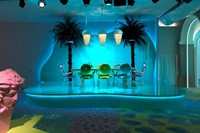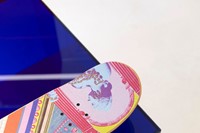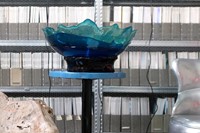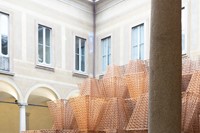Minimalism is dead, long live the maximalist. Milan Design Week 2019 might not have been a vintage outing for the world’s most influential and heavily attended interior design showcase, but the largely underwhelming offering presented by many of the less experienced – or simply less imaginative – studios allowed for Italy and the fashion world’s biggest names to demonstrate why they lead, while everyone else follows. The overwhelming message sent to the interior designers of the world by the likes of Gucci, Versace and Dimore? Disciples of restrained Scandi-style and Kondo-inspired reserve need not apply.
Navigating the city’s cobbled streets, shoulder to shoulder with almost 390,000 other visitors attending Salone del Mobile Milano, experiencing everything is almost impossible but, armed with a designer’s go-to itinerary, we found some firm favourites.
Palazzo Versace
An oasis of calm Palazzo Versace is not, but what it offers in terms of excitement, nostalgia and a sense of behind-the-scenes secret-keeping is enough to excite even the most cynical of design aficionados. For the first time in the brand’s history, the entire palazzo has been transformed in order to showcase a wild-hued, utterly excessive Versace Home collection, created in collaboration with American interior designer Sasha Bikoff and Canadian artist Andy Dixon. Kimono motifs adorn fuschia pink wallcoverings, neon bedwear invites you to do anything but sleep and a graphic branded carpet leads from room to jaw-dropping room, including Donatella’s very own fittings dressing room.
Dimore Milano
Where Versace nails kitsch opulence and Gucci rebrands chintz, Italian-American Milan-based design duo Dimore find refined glamour in both decay and hedonism. Staged inside one of Milan’s decadent but abandoned cinemas, Interstellar reminds us of the atmospheric power that can be harnessed when the creative curation of individual pieces, lighting and sound production is done right. Walking in from the crowded streets of the city visitors are plunged into a darkness that serves to allow Bowie-inspired graphic textiles and glowing metallic finishes to transport us to an intergalactic, 1970s fantasy.
Raf Simons x Kvadrat
It is notoriously difficult to showcase fabric collections alongside the work of studios producing objects and furniture, but Raf Simons and Kvadrat have been working together long enough to know just how much theatre to borrow from the world of fashion in order to put on a show that draws in the crowds. Five years since the pair’s collaboration began, this year’s ‘No Man’s Land’ installation enticed visitors with a Mark Colle-curated indoor flower garden and a warehouse-style gallery space featuring the Raf Simons work-in-progress themed collection housed in a series of prefab buildings designed by design icon Jean Prouvé.
HEMMA gone wild
Nordic designers, as we know, are synonymous with minimalism, so it was both unexpected and refreshing to see HEMMA gone wild taking more than just a playful approach to design this year, but one that celebrates the poetry of impracticality and absurdity. Housed over two floors in the heart of the famed Brera Design District, Swedish Design Moves’ group installation Hemma Gone Wild moves beyond pragmatism and plywood to explore and invert our perceptions of homeware and ritual, highlighted particularly well by Jessica Westerberg’s simply named ‘Potato table vases’, inspired by a Midsummer table setting in Dalarna where the table was decorated with potatoes.
Paola Navone x Corsi Design
While the immediate appeal of industry icon Paola Navone’s debut collaboration with Corsi Design is rooted in her haphazard approach to structure and paint-splatter pattern, the real intrigue kicks in when you begin to feel your way around the collection. Fingertips expecting to navigate the fragility and rigidity of Murano glass are confronted with a jelly-like resin material that ripples and flexes at the first hint of contact. Resin may not have the environmentally sound appeal of materials such as glass, but to see a designer reimagining the materials of a 1,500-year-old craft is quite a spectacle and sure to provoke murmurs and rumblings from Venetians far and wide.
COS x Mamou-Mani
This year’s COS installation concept was going to need to be strikingly different to 2018’s Phillip K. Smith lll installation to stand any chance of lingering in the mind, particularly as it inhabits the very same venue, Palazzo Isimbardi. Thankfully, London-based French architect Arthur Mamou-Mani and his eponymous studio’s aesthetically delicate 3D-printed structural creation wrapped the palazzo’s historic architectural features with a precision reflective of a digital age while demonstrating that 700 sustainable ‘bio-bricks’ can mirror and merge with the branches of even the smallest trees.






























